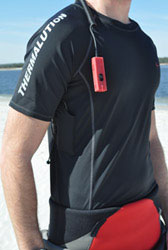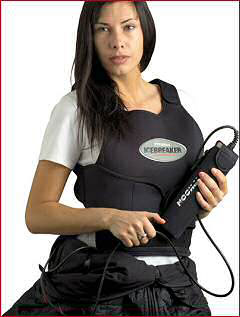What’s a Heated Vest, and Should You Buy One?Contents of this Issue: Kona Diving Company, Kailua-Kona, Hawaii Aqua Lung Recalls All BCs with SureLock II Weight Pockets What’s a Heated Vest, and Should You Buy One? Komodo Resort Diving Club, Indonesia The “Ship of Gold” Treasure Hunter Captured In Florida Lionfish Aren’t the Only Invaders in Florida Waters Stop Panic Before It Starts Underwater Dead Diver’s Wife Sues a Shadow Diver Star Want to Put Your Name on a Reef? Got $100,000? Editorial Office: Ben Davison Publisher and Editor Undercurrent 3020 Bridgeway, Suite 102 Sausalito, CA 94965 from the March, 2015 issue of Undercurrent
In this story on Kona diving, our reporter envies the heated vests she sees fellow divers wearing, and how toasty they look while wearing them in those cool waters. Are these battery-powered vests worth spending up to $1000 on? John Bantin, our veteran dive gear tester, has tried on a few, and here are a couple of his picks sold in the U.S.
"The controller's battery life is around 18 months, so I guess that will be an ongoing expense when the time comes to replace it, because it is factory-sealed. The main batteries are simply disconnected from the suit and reconnected to a multi-voltage intelligent charger. They take around eight hours to fully charge, and are claimed to be good for around 500 recharges. A fully charged pair of batteries are said to last for between three and four hours, so that should be enough to suit even the most adventurous diver." ( $500; 2.5 pounds; www.thermalution.com ) Typhoon Icebreaker: "High-tech in design but low-tech in operation. It uses a flexible intelligent polymer containing thousands of conductive carbon particle chains in panels within a neoprene vest, which, with the aid of Velcro-covered sections, can be adjusted to fit almost anyone. Power is supplied as a rapid pulse. The designer promised it could be completely soaked and, as it contained no electrical components, would still work safely. The current flows and it gets warm. It's that simple. It uses so little power to heat up that a relatively small 4A/h lithium-iron battery is used. That holds enough charge for around 70 minutes and more - but you don't switch it on until the last part of your dive, or you carry more battery power. Once the material reaches a certain temperature, it self-regulates. The conductive particle chains in the suit vibrate when the current flows. They get warm but the material that forms the heating element will not exceed 108 degrees Fahrenheit - warm, but not warm enough to cause discomfort.
|

I want to get all the stories! Tell me how I can become an Undercurrent Online Member and get online access to all the articles of Undercurrent as well as thousands of first hand reports on dive operations world-wide
| Home | Online Members Area | My Account |
Login
|
Join
|
| Travel Index |
Dive Resort & Liveaboard Reviews
|
Featured Reports
|
Recent
Issues
|
Back Issues
|
|
Dive Gear
Index
|
Health/Safety Index
|
Environment & Misc.
Index
|
Seasonal Planner
|
Blogs
|
Free Articles
|
Book Picks
|
News
|
|
Special Offers
|
RSS
|
FAQ
|
About Us
|
Contact Us
|
Links
|
3020 Bridgeway, Ste 102, Sausalito, Ca 94965
All rights reserved.

 The Thermalution Compact Dive Series (70mm): "I first tried this out in the
some-would-say balmy Caribbean waters of Grenada in the Caribbean. (Am I
a man or a mouse? Squeak!) The undervest worked well under my wetsuit. It's
made of a Lycra-like fiber, and has a non-metallic heating panel built into the
back. Two pockets take the twin battery-packs, the size of a cigarette case. They're
connected to the vest via cables with wet-connectors. Strangely, the designers
have put the receiver unit for the wireless connection in the small of the back, so
you wear the vest under your suit, and the controller straps onto a forearm. There
are three progressive settings, and an LED indicator that goes from green through
orange to red. To confirm that the receiver is working, it vibrates for a second,
twice for the mid setting, and three times for the highest heat setting. It gives a
single long vibration to confirm it's shutting down -- it's a bit like having a small
mouse inside your suit with you.
The Thermalution Compact Dive Series (70mm): "I first tried this out in the
some-would-say balmy Caribbean waters of Grenada in the Caribbean. (Am I
a man or a mouse? Squeak!) The undervest worked well under my wetsuit. It's
made of a Lycra-like fiber, and has a non-metallic heating panel built into the
back. Two pockets take the twin battery-packs, the size of a cigarette case. They're
connected to the vest via cables with wet-connectors. Strangely, the designers
have put the receiver unit for the wireless connection in the small of the back, so
you wear the vest under your suit, and the controller straps onto a forearm. There
are three progressive settings, and an LED indicator that goes from green through
orange to red. To confirm that the receiver is working, it vibrates for a second,
twice for the mid setting, and three times for the highest heat setting. It gives a
single long vibration to confirm it's shutting down -- it's a bit like having a small
mouse inside your suit with you. "With no thermostat, how do you turn it on and off? You must adapt your
wetsuit or drysuit by punching a 13mm hole through its fabric to fit the electrical
connection. On the inside of this waterproof bulkhead connector is a lead and
plug that connects to the heated vest's lead. On the outer side is a two-pin (plus
guide-pin) waterproof connector. Mount the battery-pack where you wish and
feed its lead to this. Connect when you get cold. Disconnect if you feel too warm.
The wet-connector comes with a blanking plug-end to the battery lead to stop
unwanted discharge through the water over the longer periods when it may not be
connected. The battery-pack is small enough to fit a BC pocket. The best place to fit
the bulkhead connector is on a thigh, as you can see it and get to it easily." ( $1,000;
0.44 pounds;
"With no thermostat, how do you turn it on and off? You must adapt your
wetsuit or drysuit by punching a 13mm hole through its fabric to fit the electrical
connection. On the inside of this waterproof bulkhead connector is a lead and
plug that connects to the heated vest's lead. On the outer side is a two-pin (plus
guide-pin) waterproof connector. Mount the battery-pack where you wish and
feed its lead to this. Connect when you get cold. Disconnect if you feel too warm.
The wet-connector comes with a blanking plug-end to the battery lead to stop
unwanted discharge through the water over the longer periods when it may not be
connected. The battery-pack is small enough to fit a BC pocket. The best place to fit
the bulkhead connector is on a thigh, as you can see it and get to it easily." ( $1,000;
0.44 pounds; 